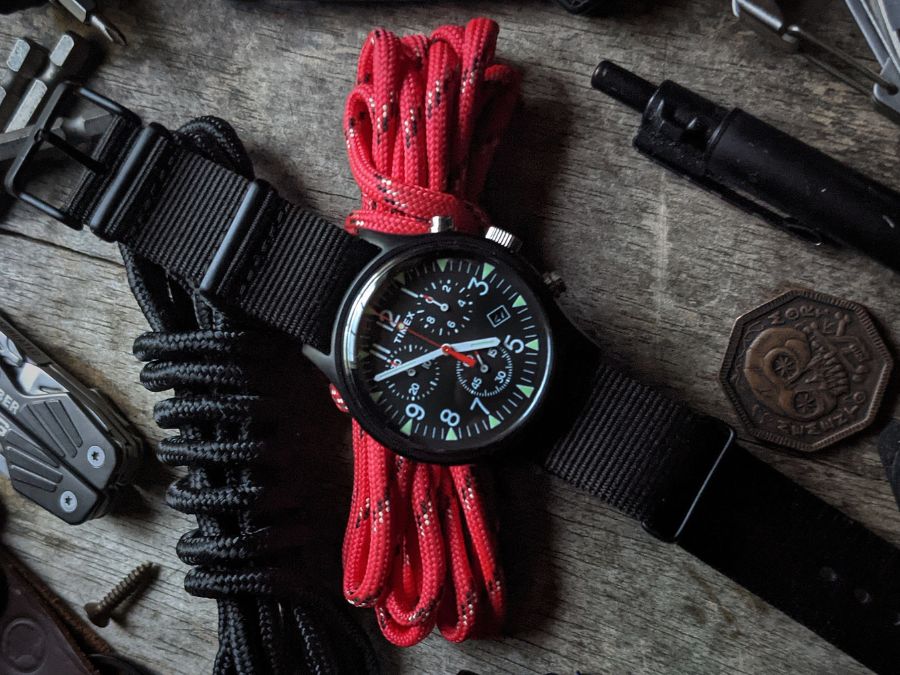Timex MK1 Chronograph Review
A Deep Dive Into The Timex MK1 Chronograph
Back in the 1960s and 70s, the U.S. military needed watches that were accurate, easy to read and cheap to produce. They needed watches that were essentially disposable. Timex made quite a few of those watches, designed to MIL-W-46374 military specifications and distributed to U.S. Marines, who wore them during the Vietnam War.
The modern Timex MK1 Chronograph series of watches is essentially an homage to those classic timepieces. The originals were utilitarian, and their modern counterparts are much the same. That’s not a bad thing.
Personally, I like Timex Chronograph watches because they’re handsome, reliable watches that I don’t have to be too precious about. I wouldn’t go so far as to call them “disposable,” but I can wear them camping and hiking with full confidence that they’ll get through the experience unscathed (and if they don’t… hey, I’m only out about 40 bucks).
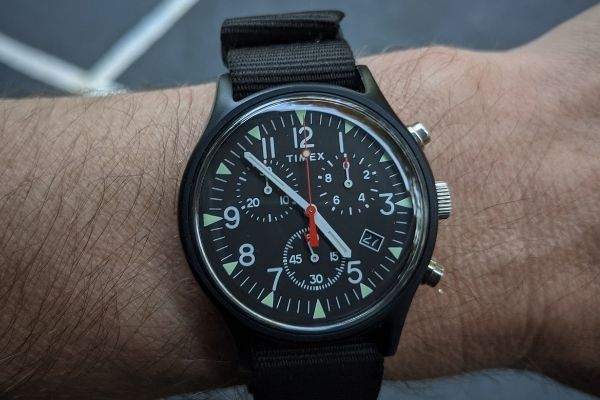
The Timex MK1 Chronograph is a great beater watch for any watch geek who doesn’t want to expose their pricier pieces to the wear and tear of the backcountry. But these are also excellent entry-level watches.
If you’re interested in buying your first watch, consider this one. You might find that it’s a bit like a gateway drug.
Timex offers quite a few models within their MK1 line of watches. The one I’ve been wearing on my arm for the last month or so is a Timex MK1 Chronograph with model number TW2T10900. It shares a lot with its predecessors in terms of functionality, but compared to the resin-cased U.S. Marine-issue watches of yesteryear, it’s quite a few steps up.
First and foremost, it incorporates Timex’s trademark Indiglo function (more on that later) and features an aluminum case, stainless steel back and acrylic crystal. Today’s MK1 chronograph is also a quartz watch.
With all that in mind, it’s clear that the designers of the MK1 have a great respect for the heritage behind this watch, as well as an understanding of the demands of today’s watch wearers and collectors. The end result is a perfect balance of both, and not bad bang-for-your-buck, if I do say so myself.
At this price point, I’m not going to nitpick about details like the precision of the quartz movement or how well each hand aligns with the indices. Nobody would argue that this is the best watch money can buy.
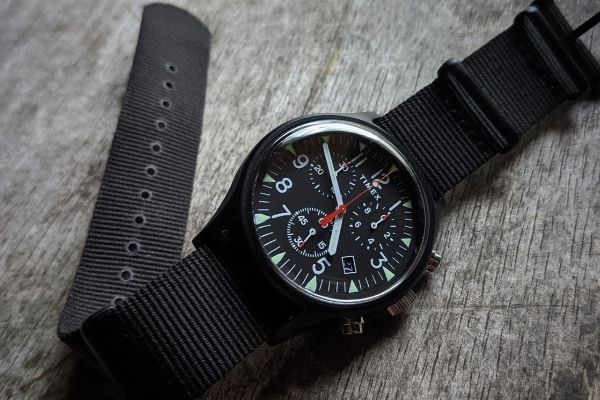
But is it the best watch 40-ish dollars can buy? IT JUST MIGHT BE.
Let’s talk about the details. My Timex MK1 Chronograph has a 40mm case (15mm thickness) which is a very comfortable size for my wrist. It’s also very light. I mean, almost startlingly light. Aside from the stainless steel back, the case is made of aluminum, which is the main reason this thing weighs in at a mere 1.41 ounces.
This watch comes in a few different colors. Mine is grey, but the black model is also a good-looking watch, and I hemmed and hawed for a while before I was able to decide between the two. Ultimately, I’m happy with my choice. The natural matte grey finish of the aluminum case is very smooth, with an almost gunmetal-like appearance. The dial, while also described as grey, is such a light shade of that color that it almost scans as white.
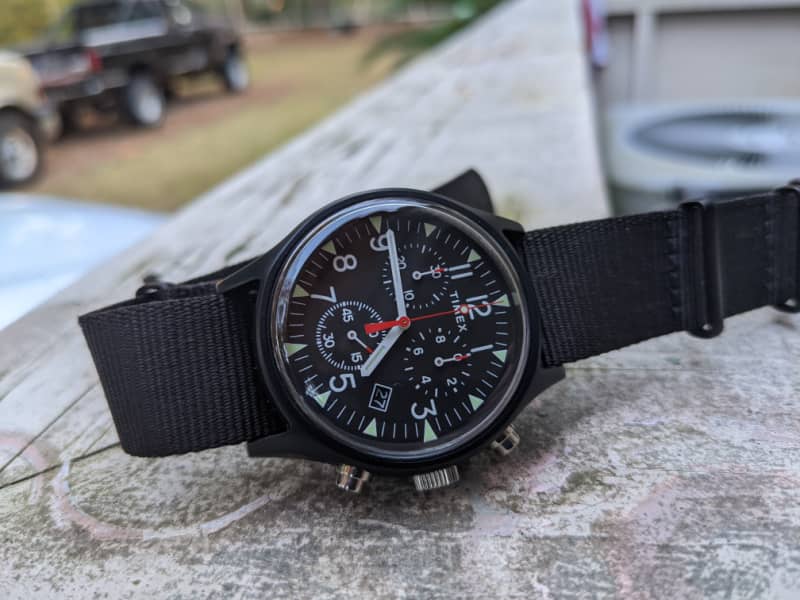
Both the case and dial have a crisp, clean design. As you might expect, it’s a very classic-looking watch, rugged and unfussy. That’s not to say it doesn’t look good. It does. But there’s an admirable simplicity to the whole package. You’d never mistake it for a decorative piece.
The case is also designed to give you 30 meters of water resistance. Again, that’s water resistance. This watch is not waterproof, nor does it claim to be. It’s simply not meant to be a diving watch. That being said, I’ve worn mine in the shower and hiked with it in the rain multiple times with no ill effects.
I’ve seen a lot of criticism directed toward this watch on account of the acrylic crystal, which some say is easy to scratch. I don’t know what these people are doing to their watches, but I’ve worn my MK1 through some pretty rumble-tumble situations, and have yet to see a scratch appear. Take that for what it’s with, I guess. The acrylic crystal is also period-accurate to the old watches the MK1 is made to emulate, so I appreciate the attention to detail.
The dial itself is easily readable at a quick glance. There’s good-not-great luminescent material on the hour, minute and second hands, as well as each hour marker. It’s perfectly adequate, no more and no less. What I really like is the Indiglo feature, a hallmark of Timex watches that illuminates the dial with a push of the crown.
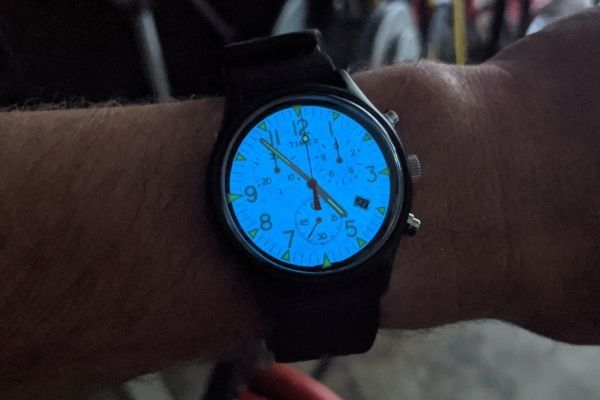
The Indiglo is barely noticeable in the daylight, but it produces a brilliant blue glow in the dark. Honestly, it’s just fun to play with. I’m no scientist, but Indiglo is a form of electroluminescence, and this How Stuff Works article does a good job explaining how it works.
As long as we’re talking about the crown of the MK1, it does a lot more than activate the Indiglo. The crown is also used to adjust the hour and minute hands, which are each—and this is a feature I really appreciate—independently adjustable. That means you can move the hour hand without moving the minute hand. If you’re someone who frequently travels between time zones, then I don’t have to tell you what a helpful feature that is.
You simply pull out the crown one click to move the hour hand, and a second click to move the minute hand. My MK1 Chronometer also has a small window on the dial that displays the date, and you can adjust the date by moving the hour hand past the 12 o’clock position twice in either direction.
The chronograph pushers are located to the right of the dial, on either side of the crown. There’s a bit of a learning curve to using the chronograph feature of this watch, but Timex has a thorough online instruction manual that you might find helpful ( it would have been nice if this had come with the watch, but alas, it did not).
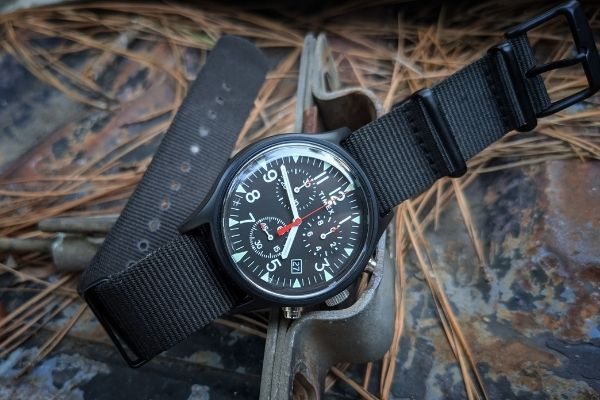
Suffice to say, with a little practice, you can easily use the Timex MK1 Chronograph as a stopwatch and to measure time and distance. The three small sub-dials on the watch face represent three different aspects of the chronograph feature. You have running seconds at the 6 o’clock position, a 30-minute counter at 10 o’clock, and a 1/20th of a second indicator for more precise chronograph reading at 2 o’clock.
My Timex MK1 Chronograph came with a pretty basic grey fabric strap. It’s nothing to write home about, but it looks pretty good against the darker grey of the aluminum dial. You could very easily remove it and upgrade the strap—20mm lugs make it easily adaptable—but I left mine on because I often wear this watch outdoors and the original strap is well suited to that.
HERE’S THE LAST THING I’LL SAY ABOUT THE MK1.
Anytime I hear someone say a watch is “great for the price” that always rings a little hollow for me. It’s almost like damning with faint praise.
This is a great watch for the money, but it’s honestly a very good watch when you take price entirely out of the equation. With multiple color options (not to mention several other models in the MK1 line) these are watches you can wear just about anywhere. Not only are they great outdoorsy watches, but you could strap one on when you’re going to a party or a nice restaurant, and it wouldn’t draw any second glances.
I love that the MK1 Chronograph pays tribute to the U.S. Marines watches from decades ago, but the improvements Timex has integrated into the design make it a great watch for right now.
If you’re thinking about getting into watches, this the MK1 makes for a great first buy. And if you already own a dozen watches that are much more high-end, this is still a worthy entry into your collection.

Alan Dale is an experienced backpacker and adventure sports athlete who pays the bills by writing. Married with a small brood, Alan often has his kids in tow on many of his adventures. You can visit Alan here: https://siralandale.com/

